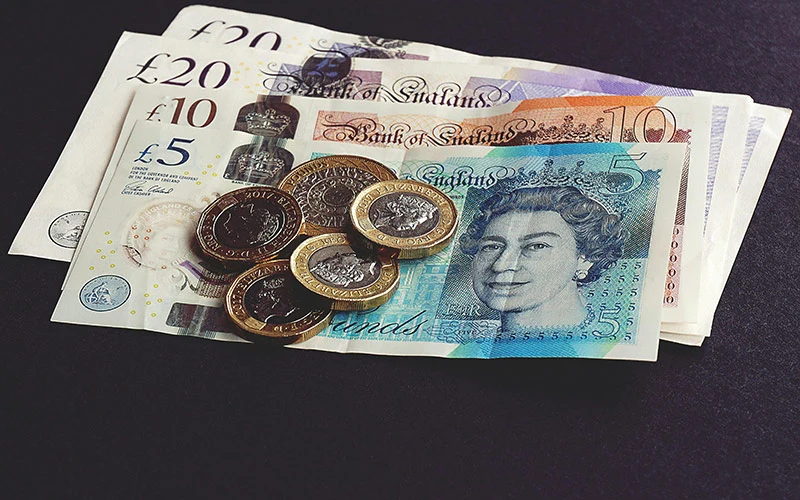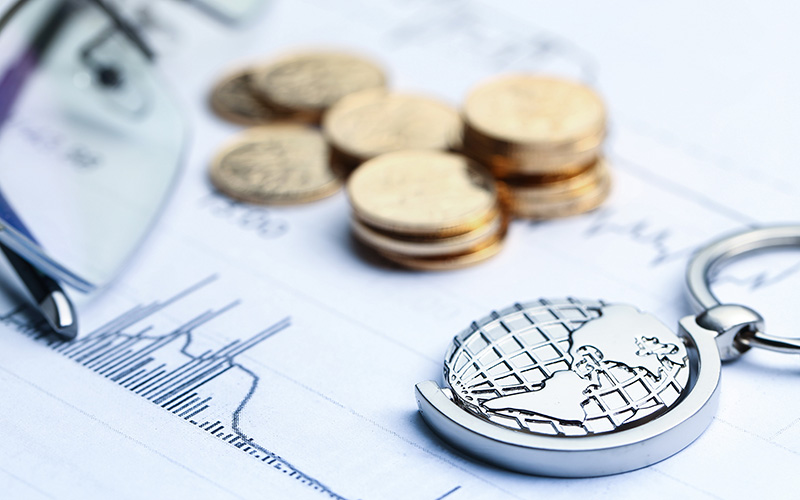While visiting the UK, tourists need to know what currency does UK use? The Sterling Pound is the official currency of the United Kingdom. It is the fourth most traded currency in the world and the oldest still in use.
The £ sign, which is the UK currency symbol, is derived from the Latin term libra. It means balance or weight. In the UK, this sign appears in pricing listings on anything from menus to tickets for public transportation.
The current UK currency features either King Charles or the late Queen Elizabeth II after her death. The face of King Charles appeared on coins issued in 2023. On 5 June 2024, his picture appeared on banknotes. Every currency issued by Queen Elizabeth is still and will continue to be legal.
Denominations of British Coins

British coins are used extensively in everyday transactions and come in a range of values. Coins come in different shapes, sizes, and colors. The backs of every penny coin were altered in 2008 to depict various Royal Shield segments. The following coins are used in the UK.
1) One Pence Coin
The One Pence copper coin is often referred to as a penny. It is the British currency with the lowest value.
2) Two Pence Coin
The copper structure of the round-shaped Two Pence coins makes them different from others. The design remains the same, featuring the faces of either King Charles or Queen Elizabeth, along with a portion of the Royal Shield.
3) Five Pence Coin
Five pence coins are spherical and made of silver, with a portion of the Royal Shield on the back and Queen Elizabeth II or King Charles on the front. But compared to the 50p, 20p, and 10p coins, the 5p coin is substantially smaller.
4) Ten Pence Coin
The circular, silver 10p coin features a portion of the Royal Shield on the back portion of the coin. And a picture of King Charles or Queen Elizabeth II on the front side.
5) Twenty Pence Coin
Twenty Pence coins are silver, seven-sided, and have a fragment of the Royal Shield on the back and an image of Queen Elizabeth II or King Charles on the front.
6) Fifty Pence Coin
The 50 Pence Coin is similar to the 50 Pence Coins. You will need to examine the label on the reverse of each coin to tell them apart. A silver coin with seven sides. Since its creation in 1969, the coin has had the image of Queen Elizabeth on the front. Now it has a picture of King Charles.
7) One Pound Coin
The one-pound coin is bimetallic and features a design of Queen Elizabeth II by Jody Clark on the front. The modern One Pound coin, which debuted in March 2017, is 12-sided. It features an entirely different reverse design. The English rose, Scottish thistle, Welsh leek, and Northern Ireland shamrock all emerge from the top of a crown. This is to honor the four nations that make up the United Kingdom.
8) Two Pounds Coin
The edge of the British two-pound coin is gold, whereas the middle is silver. Three different pictures of Queen Elizabeth II have been on the two-pound coin since its introduction in 1997. Now, King Charles is featured.
British Notes

In recent years, the Bank of England has introduced polymer banknotes. They are in the denominations of 5, 10, 20, and 50. Compared to conventional paper, the polymer used to make these notes is more resilient and waterproof. Holograms, see-through windows, and raised print are some of the improved security features on these polymer banknotes that help stop counterfeiting. You can see notable historical personalities, such as Jane Austen and Winston Churchill featured on each note.
1) Fifty Pound Note
The first governor of the Bank of England, Sir John Houblon, was featured on the 50 Pound Note. Later, Matthew Boulton and James Watt were featured on the note. A Fifty Pounds polymer note featuring the renowned codebreaker Alan Turing was issued in 2021.
2) Twenty Pound Note
In March 2007, the Adam Smith 20 Pound Note was released by the Bank of England. Like the original 20-pound note, which featured English musician, Sir Edward Elgar, it is the same size and mostly the same purple color. The famed British painter JMW Turner was featured on a new 20-pound note that replaced the Adam Smith bill in circulation in 2020.
3) The Old Ten Pound Note
The 10 Pound Note issued by the Bank of England is frequently referred to as a tenner. Charles Darwin, famous for his theory of evolution and natural selection, is included in older editions. In March 2018, the Charles Darwin paper note that has been in circulation since 2000 was taken out of circulation.
4) The New Ten Pound Note
A yellow-orange, waterproof, plastic 10-pound note depicting famous author Jane Austen was unveiled in September 2017. The front features Winchester Cathedral in gold foil, a see-through image of Queen Elizabeth II or King Charles, and a brand-new hologram featuring the crown. The back features a depiction of Elizabeth Bennet, a phrase from Pride and Prejudice, a profile of Jane Austen, and a picture of Godmersham Park.
5) The Old Five Pound Note
Circulated in 2001, this old Five Pound note, commonly known as a fiver was stopped in circulation in May 2017. It portrays Elizabeth Fry, a philanthropist and prison reformer from the 19th century. Often referred to as the angel of prisons, Fry supported laws that encouraged prisoners to be treated with compassion.
6) The New Five Pound Note
The most current Five Pound note was introduced in the fall of 2016. It features Sir Winston Churchill on one side and a photograph of Queen Elizabeth II or King Charles on the other. Improved security features are said to make these vivid teal blue notes cleaner and harder to counterfeit.
Tips for Using Money in the United Kingdom
Here are some useful pointers to effectively manage your currency in UK.
1) When creating your vacation itinerary, remember to include the UK Visa Requirements. For more choices and better prices, travelers could convert their money before their trip or in major UK cities. At transportation hubs, private currency exchange agencies typically charge higher fees.
2) Having British pounds in small denominations is helpful for little purchases, tipping, and public transportation in some locales, even though most establishments accept card payments.
3) The UK is a very tech-friendly country. Make use of mobile and contactless payments.
4) You can use mobile apps to manage your spending and convert currencies. Popular apps like Monzo, Wise, or Revolut help to keep track of your purchases and manage your spending.
5) Request a variety of denominations when exchanging money.
Currency exchange in the United Kingdom

There are alternative ways for tourists to exchange their local currency for United Kingdom currency without going to a bank.
Most towns, cities, and significant transportation hubs have bureaux de change, or currency exchange shops, like Travelex. Popular department stores and post offices also provide money exchange services.
It is best to examine who offers a decent bargain in advance because commission costs and exchange rates vary. Every day, exchange rates can change. Asking for the amount of pounds you will receive after all expenses are subtracted is the easiest approach to determine which choice is best.
Since there could not be another money exchange facility in the area, it is preferable to exchange money at the point of entry when visiting a rural area.
How to Prevent Counterfeit Money
To combat counterfeiting, the UK has implemented high-security polymer notes. To avoid counterfeit British money, make sure to,
1) Always exchange money at reputable outlets.
2) Check notes for raised print, transparent windows, and holograms.
3) Take a note to a local bank or post office to have it verified if you think it might be fraudulent.
FAQs for the UK Currency Guide for Travelers
1) Is it better to exchange money in my home country or upon arrival in the UK?
Exchange rates are often better in the UK, especially at post offices, banks, or currency exchange offices in cities. Avoid exchanging money at airports, where rates tend to be less favorable.
2) Is it possible to pay with a card anywhere in the UK?
In the UK, contactless and chip-and-pin card payments are commonly accepted. Card payments are accepted even in small businesses, marketplaces, and taxis. Apple Pay and Google Pay are two well-liked mobile payment methods.
3) Which UK coin and banknote denominations are in circulation right now?
The denominations of coins used at present in the UK are 1 pence, 2 pence, 5 pence, 10 pence, 20 pence, 50 pence, 1 pound, and 2 pound. The denominations of the notes are 5 pounds, 10 pounds, 20 pounds, and 50 pounds. Since all of the notes are polymer, they are long-lasting and waterproof.
4) Where can I withdraw British Pounds in the UK?
ATMs or cash points are available for cash withdrawal at banks, supermarkets, rail stations, and airports. The majority of machines take foreign cards. However, be sure to check your bank for fees associated with overseas transactions.
5) After my vacation, is it possible to exchange any leftover pounds?
You can trade any leftover GBP at airports, banks, or currency exchange desks. Coins in small amounts can be donated in airport charity boxes or kept as mementos.
Take Note
The UK visa application fee for a UK visa must be paid in British pounds at the time of submission. Online payment portals for visa applications show the fee in GBP regardless of whether you are applying from abroad or within the UK. The UK Visitor Visa Fees will vary depending on the length of your stay.
